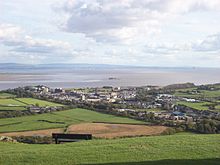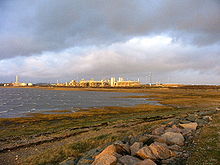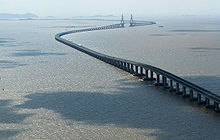
Morecambe Bay
Background Information
The articles in this Schools selection have been arranged by curriculum topic thanks to SOS Children volunteers. SOS Children has looked after children in Africa for forty years. Can you help their work in Africa?
Morecambe Bay is a large bay in northwest England, nearly due east of the Isle of Man and just to the south of the Lake District National Park. It is the largest expanse of intertidal mudflats and sand in the United Kingdom, covering a total area of 310 km². In 1974 the second largest gas field in the UK was discovered 25 miles west of Blackpool, with original reserves of over 7tcf. At its peak 15% of Britain's gas supply came from the bay but production is now in decline and the main field was mothballed in 2011.
Natural features
The rivers Leven, Kent, Keer, Lune and Wyre drain into the Bay, with their various estuaries making a number of peninsulas within the bay. Much of the land around the bay is reclaimed, forming salt marshes used in agriculture. Morecambe Bay is also an important wildlife site, with abundant bird life and varied marine habitats, and there is a bird observatory at Walney Island. The bay has rich cockle beds, which have been fished by locals for generations.
History
There have been royally appointed local guides (holding the post of Queen's Guide to the Sands) for crossing the bay for centuries. This difficulty of crossing the bay added to the isolation of the land to its north which, due to the presence of the mountains of the Lake District, could only be reached by crossing these sands or by ferry, until the Furness Railway was built in 1857. This skirts the edge of the bay, crossing the various estuaries. The London-Glasgow railway also briefly runs alongside the bay - the only place where the so-called West Coast Main Line actually runs alongside the coast.
The bay is notorious for its quicksand and fast moving tides (it is said that the tide can come in "as fast as a horse can run"). On the night of 5 February 2004, 23 Chinese immigrant cockle pickers drowned after being cut off by the tides. This tragedy led some commentators to suggest that the cockle beds should be closed until improved safety measures could be introduced.
Morecambe Bay was featured on the television programme Seven Natural Wonders (BBC) as one of the wonders of the North.
Settlements
Some 319,100 people live along the coastline of Morecambe Bay, with many of these people residing in the towns listed in the table below. The largest town by far on the bay is Barrow-in-Furness located to the north-west of it, whilst the town which adopted its name from the bay ( Morecambe was previously called Poulton-le-Sands) has a population of around half of Barrow's. Morecambe relied on the bay for many years, as a popular seaside holiday destination, whilst Barrow still relies on the seas for a large percentage of its economy - Ship and Submarine building.
| Town | County | Population |
|---|---|---|
| Barrow-in-Furness | Cumbria | 59,256 |
| Morecambe | Lancashire | 45,000 |
| Fleetwood | Lancashire | 26,840 |
| Ulverston | Cumbria | 11,210 |
| Heysham | Lancashire | 6,500 |
| Grange-Over-Sands | Cumbria | 4,000 |
Natural gas
The bay has Britain's second-largest natural gas field, in the Triassic Sherwood Sandstone with a seal of Mercian Mudstone and a Carboniferous source. The South Morecambe Field, covering an area of 32 square miles, was discovered in 1974 and the first gas came ashore in 1985. The North Morecambe Field, found in 1976 8 miles (13 km) to the north, is 11 square miles and started production in 1994. Both are operated by Centrica Energy. They are 25 miles west of Blackpool in 30 metres of water; the top of the gas reservoir is at a depth of just 900 metres (3,000 ft), necessitating slant drilling for the first time in European waters. The combined gas reserves on discovery were estimated at 179 billion cubic meters (6.45 tcf). A further 0.65tcf is recognised in the satellite fields of Bains, Calder (Rivers), Dalton, Millom East and Millom West, and a number of smaller fields have been identified.
The gas is landed at three terminals at Westfield Point in Barrow-in-Furness, collectively referred to as the Rampside Gas Terminal. The South Morecambe Central Processing Complex is connected via a 36 inch pipeline to the South Morecambe terminal. North Morecambe gas has a different composition so the unmanned Drilling and Production Platform is linked by a separate 36" wet sealine to the North Morecambe Terminal, where it is stripped of water, CO2 and nitrogen. The Rivers Terminal has a dedicated pipeline for sour gas from the Calder field, which must be stripped of hydrogen sulphide before processing by the North Morecambe Terminal. The hydrogen sulphide is converted to sulphuric acid which is sold for industrial use. In 1991 a 229MW CCGT power plant was opened near the terminals, on the site of the former coal-fired Roosecote Power Station. There is a support base at Heysham Port and personnel are typically moved by helicopter from Blackpool International Airport. Five rig workers and the two pilots of a Eurocopter AS365 Dauphin were lost when it crashed in sight of the platform on 27 December 2006.
At peak production 15% of UK supply came from the two main fields. As of 2006 Centrica reckoned there was about 1.2tcf of economic gas remaining in them, and they planned to operate the fields for another 10-15 years. In June 2011 they announced the South Morecambe field would be mothballed with the intention of producing it at times of high gas prices. This was the result of tax increases in the 2011 Budget which meant South Morecambe would be paying a rate of 81% tax; North Morecambe and Rivers would continue in production as they are taxed at 62%.
Bridge proposal
Discussions as to whether to build a road bridge over the bay have been ongoing for decades, particularly in the more isolated north of the bay. The most recent suggestion was of a "green bridge", flanked by wind turbines and using tidal power to mitigate the environmental damage of its construction. The bridge would be twelve miles (19 km) long making it the longest bridge in Europe. It would stretch from Heysham to Barrow-in-Furness, at the bay's mouth. Feasibility studies are ongoing, though over two years since this version of the bridge was proposed, little progress has been made. In the 2005 UK General Election, Timothy Bell polled just 1.1% of the votes in the Barrow and Furness constituency for the Build Duddon and Morecambe Bay Bridges Party.
A lease has been granted for developing two wind turbine sites in the bay, one at Walney Island and the other at Cleveleys. Together these will have around 50 turbines.
The bridge could produce 200 MW of renewable energy from a tidal stream system, enough to power over 400,000 homes. The results of turbine tests in the Bay, promised for the summer of 2009, have yet to appear in the local press. The marine environment of the Bay is notoriously volatile, and some local opinion has doubted whether turbines could function effectively in such a setting.
Members of Parliament in West Cumbria have hailed the bridge as a saviour for local industry. The project's backers, Bridge Across the Bay Ltd., have compared the proposed bridge's importance to that of the Øresundsbron (the Øresund Bridge) near Copenhagen and the Angel of the North. Bridge Across the Bay Ltd. intends to seek planning permission in 2010. Subject to approval and the problematic provision of finance, construction could begin around 2011, and the company estimates the bridge could be completed in 2015.





